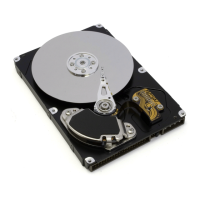10.17 Reset
The Reset condition is used to clear all SCSI devices from the bus. This condition takes precedence over all
other phases and conditions. After a reset condition is detected and the reset actions completed, the target
returns to a 'SCSI bus enabled' state that allows the target to accept SCSI commands.
This device uses the Hard reset option as defined in the SCSI-2 standard.
10.17.1 Reset Sources
There are four sources of resets detected by the target:
Reset Name Reset Source
Power-On Reset This is the signal generated by the hardware at initial power-on
Self-Initiated reset This is a software-generated reset that occurs when a catastrophic error is detected by
the microcode.
SCSI Bus Reset This is a reset generated when the SCSI bus control line RST goes active.
SCSI Bus Device Reset Message This is the reset generated by the SCSI Bus Device Reset Message(0Ch).
10.17.2 Reset Actions
The action taken by the Drive following a reset is dependent on the source of the reset.
10.17.2.1 Power-On reset and Self-Initiated reset
These two reset conditions cause the following to be performed in the order shown.
1. A power-up sequence
2. A start-up sequence is necessary to put the Drive in a ready state
10.17.2.2 SCSI Bus reset and SCSI Bus Device Reset message
These two reset conditions cause the following to be performed.
If reset goes active while the power-up sequence is in progress, the power-up sequence is started over.
If the Auto Start pin is grounded and a start-up sequence has not yet completed, a start-up sequence will
be re-attempted from the beginning.
Note: The power-up sequence, having already completed, is not rerun.
If reset occurs while a physical sector is being written, the write operation is disabled after the current
physical sector is written. Data is not lost as long as power stays valid until the physical sector being
written is completed.
Additional Information 195

